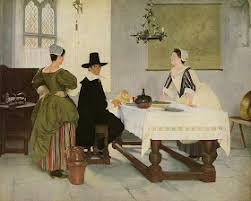 |
| As is often the case, childhood memory exaggerates size. This book is a hefty tome of biblical proportions but not quite as heavy and thick as I had remembered. The volume we had on the coffee table decades ago lacked the wear of this copy. |
So I was delighted to re-encounter this book with all the advantages of literacy and context. I read Kent's introduction and was so pleased with its kindness and good humor that I looked him up. He was a humane and decent man, an artist who found himself in trouble in the McCarthy years. He had his passport revoked in 1950 for being part of World Peace Council, which launched the Stockholm Appeal calling for nuclear disarmament. As a pacifist myself, this added to a strong sense of identity. In another serendipity, I was thrilled to find out his former artist's cottage in Maine is on Monhegan Island, just a few miles off the shore from the home of my friend Jane.
 |
| Rockwell Kent's Monhegan Bay in Winter. This hangs in the Metropolitan Museum of Art. |
I had forgotten that a Van Dyke portrait of King Charles I graces the cover. The book is indexed--all by plates as the book has no pagination. An oddity is the order of the paintings. While they start in the Renaissance and are in roughly chronological sequence, Cezanne, Renoir, and Van Gogh are stuck in the middle, ahead of Reynolds, Gainsborough, and Turner: a curiosity. Did the typesetter get confused? I don't know if that was remedied in a later edition.
I remembered almost all of the 100 plates in the way one recalls intensely the details of childhood while the important facts of the present quickly fade, but some pictures remained more firmly lodged than others in my memory.
Two that jump out at me are as follows:
The De Hooch below is called "Interior of A Dutch House." I offer a detail that shows what Kent notes--that you see the tile floor through the serving woman's skirt. Kent attributes this to the servant painted in as "a hurried afterthought." I first thought it might be evidence of a forgery, but that doesn't seem to be the case.
The fuller picture is below this, showing the height of the room and the clarity of the paint and the light.
This painting fascinated me as a child because I had never quite seen a room like this--and it seemed oddly empty to me. I was also fascinated that the floor was very much like the asbestos tile floor in our basement (though there the darker tiles were a deep green). Kent praises the simplicity of Dutch rooms, though this looks to me like a well-heeled interior. (As a child, I thought the people must be poor because of the lack of furniture.) One can vaguely see what look like bones--food refuse--thrown on the floor.
I had utterly forgotten the painting below, called "Between Two Fires" by American Francis Davis Millet, until I leafed through my newly-purchased tome. What would always startle me about this painting as a child, which I now know is a late nineteenth century evocation of a scene from the Puritan American colonies set in the same period as the de Hooch, was how oddly bright and white it was, unlike any other painting in the volume.
 |
| This internet version loses some of the startling white brightness of the painting. I learned reading Kent's introduction that Millet went down with the Titanic in 1912. |
However, a new encounter with the past changes everything, and a sense of purity gets lost as we dig beneath the surface. As Woolf says in Orlando--"Begone purity!" Or as the captain reminds Crusoe in Tournier's Friday, before the ships sinks:
“Crusoe,” he said sternly, take heed of what I say. Beware of purity. It is the acid of the soul.”
Bonhoeffer, too, deeply distrusted purity.




It's interesting you were drawn to these Dutch paintings: they are interior, homes. I don't remember when I learned to read -- or the stages. Only that I was 7 when reading a book style book (print down the page) and was reading Mary Poppins in the Park when I was 8.
ReplyDeleteI was drawn to many of the paintings, but definitely the De Hooch. Not so much the other, except for its ethereal whiteness. I read my first chapter book at 7.
DeleteWonderful story, wonderful find. Also I love the evocation of how a child first becomes involved in works of art. Mine was similar, through a book called Famous Paintings: An Introduction to Art for Young People. Also, I do love the Monhegan Bay painting! Here's the URL for the Famous Paintings book which really influenced me profoundly, lifelong: https://www.amazon.com/Famous-Paintings-Introduction-Young-People/dp/B000JIM06U/ref=sr_1_1?dchild=1&keywords=Famous+Paintings+an+introduction+to+art+for+young+people&qid=1587111419&sr=8-1
ReplyDeleteThanks Diana. I tried to look inside the book you mention, but no go! What surprises me about my art book is how many paintings of children are in--and yet that's not what I remember. But it is interesting how early a fascination with art starts.
Delete